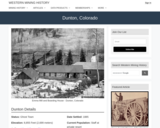This studio proposes to engage tectonics as a material process. By exploring transformation, indeterminacy and mutability inherent in material and landscape processes, students will be challenged to engage notions of duration as a design strategy for architecture and urbanism. While the second law of thermodynamics states that the material universe tends toward a state of increasing disorder, architects build and construct in opposition to these forces. Attempting to delay the processes of disorder, decay and collapse, tectonics is often seen as the embodied expression of an arrested moment-the finite resolution of the building process. Yet the processes that enable and disable architecture extend beyond any arrested moment. While the design of materials is not new, the recent evolution of mutant materials and fabrication technologies has created a material culture pregnant with possibilities. Plastics can be endowed with the properties of glass, wood made to appear like fabric, and foams given the power of memory. Materials and their methods are multiplying while our inherited notions of material significance and signification are increasingly challenged. 'Truth' in materials or in their methods of construction is no longer (and arguably never was) an absolute concept. Highlighting the multiple states of materials (raw, finished, decomposed) and new methods for fabrication (CAD-CAM, CNC, rapid prototyping), this studio seeks to understand the processes that form, deform and ultimately dematerialize built matter. This studio will explore the limits of materiality and immateriality to engage a tectonics of temporal change, transformation, and succession. Materials will be treated, not merely as finishes, but as critical points of departure for investigating new spatial possibilities. Students will design and fabricate full scale material constructs in order to explore a material's inherent properties. Investigations of casting, stressing, weathering, eroding, corroding, etc. will be part of the design process. Students will translate these studies into critical architectural propositions for the Stearn's Quarry site in Chicago. Dating back 400 million years, the site was once a part of an ancient reef near the equator before the shift in the North American tectonic plate. Rich in calcium carbonate, the 23 acre Stearns quarry site was excavated from 1936 to 1970 to a depth of 350 feet. Located within Chicago's city grid, the quarry supplied the dolomite used to line the cities waterways and yielded an unprecedented amount of fossils from the Silurian Age. Since 1970 the quarry has been used as a dumping site for incinerator ash, and construction debris. Designated a 'Superfund Site' due to concerns over its toxicity, the city of Chicago is currently examining the reprogramming, reuse and reclamation of the site. Students will design a series of architectural interventions and public interfaces to enable, support and house the geological and ecological processes and artifacts of the site. The Stearns Quarry site presents a unique opportunity to engage temporal change, transformation, adaptation and succession at the scale of the building, the city and the landscape. By engaging the materials on the site in a process of excavation, recycling, and recovery, the studio addresses a prolonged understanding of architecture, one that acknowledges duration within the framework of architectural design. Engaged in the unpredictable interface of nature, history, construction and imagination, we will attempt to arrest, reverse, stretch, divert, adhere and accelerate the temporal qualities of architecture. The studio hopes to arrive at a strategy of reworking the landscape, rather than a finite architectural object- a shift from product to process. In doing so, it seeks to unleash urban scaled material effects within the deep surface of the landscape.



















